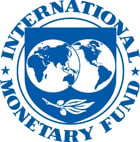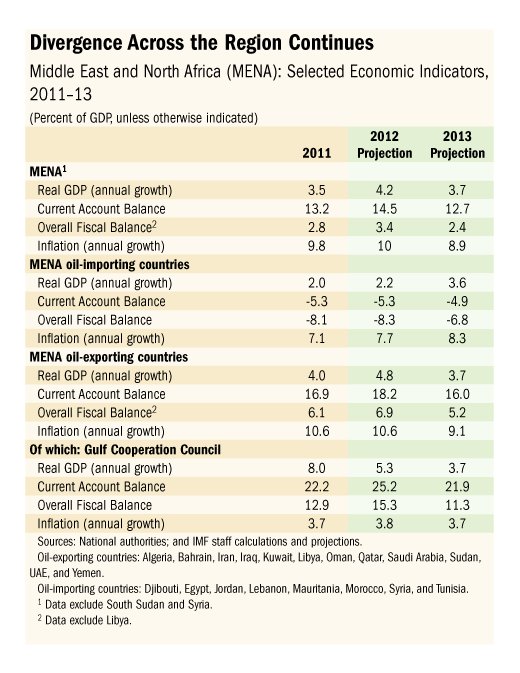
Typical street scene in Santa Ana, El Salvador. (Photo: iStock)
IMF Survey: Mideast Oil Importers Under Strain, Oil Exporters Faring Well
April 20, 2012
- Corrective measures are needed to lower oil-importers’ vulnerabilities
- Oil exporters are benefiting from high oil prices and strong buffers
- International community has key role in supporting Arab Spring countries
The Middle East and North Africa region is going through a period of dramatic change.

Luxor, Egypt: Social unrest in some countries has led to large declines in tourist arrivals, hurting the region’s growth (photo: Gavin Hellier/Robert Harding)
REGIONAL ECONOMIC OUTLOOK
In the ‘Arab Spring’ countries, political transition, pressing social demands, and an adverse external environment have combined to increase the near-term risks to macroeconomic stability, the IMF said in its latest assessment.
Moreover, many countries are faced with diminished room for policy maneuver, having eaten into their foreign exchange and fiscal buffers during 2011. There is a risk that problems in the region and elsewhere could derail the historic transition that is underway and managing this risk is a shared international responsibility. “Arab Spring countries would need support during their transitions, both in managing natural resources and in gaining global market access,” IMF Managing Director Christine Lagarde told a news conference at the 2012 IMF–World Bank Spring Meetings in Washington, D.C.
Middle East oil exporters are benefiting from high oil prices, though they face fiscal sustainability and structural issues, including the need to create jobs for their growing working-age populations, further diversify their economies, and develop their financial markets to support economic growth.
“While we are rightly focused on the short-term macroeconomic challenges, we should not lose sight of the medium-term challenges of modernizing and diversifying the economies of the region, creating jobs, and providing fair and equitable opportunities for all,” Masood Ahmed, Director of the IMF’s Middle East and Central Asia Department, told reporters.
Varied Growth
The IMF’s Regional Economic Outlook Update for the Middle East and Central Asia, released April 20, projects growth in the Middle East and North Africa region at 4.2 percent in 2012, modestly higher from 2011.
Growth among the region’s oil importers (excluding Syria)—Djibouti, Egypt, Jordan, Lebanon, Mauritania, Morocco, and Tunisia—is set to grow modestly by 2.2 percent.
By contrast, the economies of the oil-exporting countries—Algeria, Bahrain, Iran, Iraq, Kuwait, Oman, Qatar, Saudi Arabia, Sudan, the United Arab Emirates, and Yemen—are expected to expand by 4.8 percent, largely because of higher oil prices and oil production (see table).
Oil-importing countries
For this group of countries, growth is faltering, unemployment is on the rise, and government budgets are under strain. Investment and tourism activity have declined sharply. Remittances and exports have helped to hold up income in many countries.
But adverse movements in fundamentals and investor sentiment have meant
a decline in stock market indices, wider sovereign spreads, credit rating downgrades, and capital outflows from some countries (notably Egypt).
“The year ahead will be an equally challenging one, especially since many countries are faced with diminished room for policy maneuver, having eaten into their foreign exchange and fiscal buffers in 2011,” said Ahmed, adding that “as political transitions take their course, private investors will remain in a wait-and-see mode, and it will take some time for investment, tourists, and capital to come back. Moreover, the international environment remains difficult: the economic outlook for Europe is still challenging, oil prices are projected to remain high, and spillovers from Syria could affect a number of countries in the region.”
Oil-exporting countries
For 2012, growth is expected to remain steady—at 4.8 percent—and more evenly spread between the countries of Gulf Cooperation Council (GCC) and other oil exporters, as oil prices are expected to average about $115 per barrel.
In the GCC, oil and gas production is expected to remain broadly flat: Qatar’s recent rapid hydrocarbon growth is likely to tail off, pending a moratorium on capacity expansion. And an increase in Saudi Arabia’s oil production is likely to be smaller than what was required in 2011 to keep global energy demand and supply in balance. Government spending in the GCC will continue to support growth in the non-oil sector.
Despite this overall positive outlook, even amid high oil prices, fiscal sustainability is an immediate issue for those countries already running deficits, many of which are expected to rise in 2012.
In addition, a number of factors could pose risks to the oil exporters’ growth scenario. The most immediate risk would be a euro-area-induced global slowdown which would contract global oil demand and possibly lead to a sustained drop in oil prices. This would make countries with fiscal deficits especially vulnerable.
“Oil exporters also continue to face challenging structural issues, including the need to create jobs for their growing working-age populations, further diversify their economies, and develop their financial markets to support economic growth,” Ahmed told reporters.

Shared international responsibility
In its analysis, the IMF says there is a risk that domestic and external pressures will derail the historic transition taking place in the region. Oil-importing, especially Arab Spring, countries will need to set out on their own paths toward economic modernization and transformation. But they will also need to rely on financial assistance and technical and policy advice from the international community to support homegrown reform agendas.
The oil importers’ external financing needs amount to around $50 billion in 2012, and not all will be provided by capital markets. As such, it will be important to scale up the international response. The international community can also help dampen the downturn in the region by improving market access for the region’s exports.
The IMF is doing its part. Earlier this month, the IMF approved a loan for Yemen, discussions are under way with Egypt for a Stand-by Arrangement, and IMF staff is in early discussions on financing needs and possible support in a few other cases. But, “these programs will also require complementary financing from other partners,” said Ahmed.
Policy priorities
Maintaining macroeconomic stability in the current environment will be challenging, but corrective measures are needed to lower vulnerabilities, and some steps can be taken quickly. Governments must control spending on untargeted subsidies—which predominantly benefit the wealthy—and begin putting in place more effective social safety nets to protect the poor. Central banks need to maintain external stability, which may require greater exchange rate flexibility.
Beyond stabilization, countries need to make tangible progress on transforming and modernizing their economies to generate higher and more inclusive growth.


